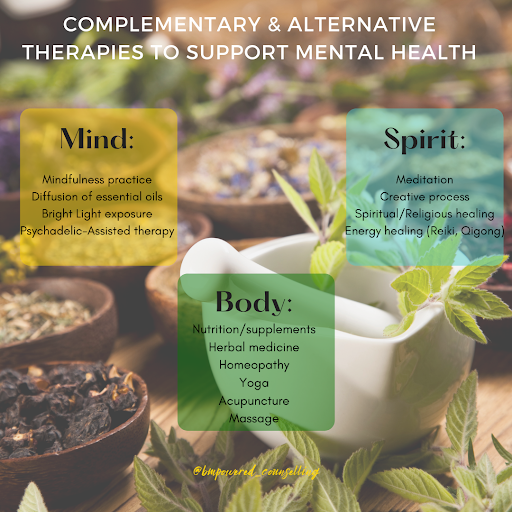Introduction
As a holistic counselor I often notice that therapy-seekers get confused about what that means, hence I’m hoping to unpack here the concept of “holistic” and apply this lens to a few common approaches in psychotherapy as well as more broadly in the field of health. Note that this is neither an exhaustive overview of the various holistic modalities, nor a comparison between these in terms of therapeutic outcomes. Although some modalities are considered to be more suitable for certain presenting issues, it is the therapeutic relationship that remains the most essential factor for the benefits of therapy.
Definition and origins
In the evolution of psychology, the holistic approach to treatment began its development as part of the humanistic view (early 20th c. with Carl Rogers and Abraham Maslow), according to which people are innately good and motivated to achieve self-actualization (i.e. reaching their full potential). This was the so-called “third force” in psychology after the psychodynamic school of thought (focusing on the unconscious reasons for dysfunctional behavior) and behaviorism (emphasizing the dynamics between behavior, consequences and cognitive processes). Additionally, the humanistic view is phenomenological in nature (emphasizing the subjective experience), and consequently dysfunctional behavior could be understood as resulting from people’s distorted interpretation of themselves and/or their past experiences. The holistic side of this view allowed for humans to be seen as complex beings with all of their aspects being interconnected. The holistic approaches that have developed over the last century emphasize the whole person along with their context, taking into consideration how recovery may be affected by factors such as age, gender, relationships, culture and faith to name a few. Additionally, the treatment focus is on wellness rather than on illness, as those approaches tend to be non-diagnostic and led by the importance of people’s subjective experiences.
Traditional talk-therapy approaches
With the birth of the humanistic view, the holistic approaches that initially gained prominence (and are still widely in use) were primarily talk-therapy modalities.
1. Existential therapy: the emphasis is on the client’s capacity for self-awareness, free will and responsibility.
2. Person-centered therapy: the emphasis is on the client and their subjective experience, as well as their potential to achieve self-actualization; according to its pioneer Carl Rogers (one of the most influential figures in the field of counseling to this day) for therapeutic change to occur only three conditions are necessary and sufficient (i.e. no therapist interventions required): congruence, unconditional positive regard and accurate empathic understanding. A few modalities branched out of person-centered therapy: Emotion-focused therapy (emphasizing the importance of awareness and acceptance of emotions), Expressive Arts therapy (emphasizing each client’s self-healing capacity through creativity), and Motivational interviewing (assuming clients’ free will and desire for positive change).
3. Gestalt therapy: stipulates that “the whole is greater than the sum of its parts”; in view of its holistic nature, the aim is to help clients expand their awareness of thoughts, feelings and actions, and to integrate those through experiments and experiences. You may read more about it here.
A more recent development in the field of counseling is represented by the systems and postmodern modalities. Some of these talk-therapy approaches could also be considered holistic to some extent.

4. Feminist therapy: it is holistic in that it takes into consideration the person along with the context; specifically, it considers any possible oppression, and/or the influence of social norms for clients of different gender identities and ethnic backgrounds in a given society.
5. Family systems therapy: focuses on a more zoomed-in context within which the client is centered, namely how each person’s experience is influenced by the role they have in the family unit as well as the expectations that come with it in a given culture, heritage, faith, etc.
6. Internal family systems: assumes that all people have “parts” and an innate core Self. The aim of IFS therapy is to help clients become aware of the interconnectedness and roles of the internal parts in order to bring them into balance (find their non-extreme roles) and enhance the function of the “system” (i.e. better serve the Self). You may read more about it here.
Body-centered approaches
Toward the end of the 20th century as mindfulness (which has its roots in Buddhism and Hinduism) gradually gained popularity in the “West”, especially with the development of mindfulness-based stress reduction by Jon Kabat-Zinn, the mind-body-spirit connection started getting more attention in the field of counseling. As part of the body-centered approaches, although one’s awareness of the mental activities is still maintained, most of the understanding and especially the processing (or releasing) of unpleasant experiences happens through embodiment – noticing and diving into one’s physical sensations, and honoring if/how/when the body needs to move.

Somatic therapy is the umbrella term for such embodiment approaches, which often are intertwined with one another, and so less differentiated compared to most of the talk-therapy approaches. If you find yourself explaining an experience, chances are that you are in a more traditional talk-therapy setting; on the other hand, if you are encouraged to notice your mental activities along with the associated physical sensations, and you allow the body to enact (perform) its experience of what you’re going through, then you move towards an enhanced mind-body connection. To facilitate the latter, therapists like myself who incorporate a somatic approach tend to utilize various practices including mindfulness, breathwork and dance to name a few. Grounding and visualization (guided imagery) exercises are common for soothing and resourcing, while more multifaceted modalities such as Somatic Experiencing®, Hakomi method, Change Triangle®, Internal Alchemy Techniques (TAI) and Emotional Freedom Technique (EFT-tapping) among others could be utilized for processing and releasing. Given that most if not all of the breath- and mindfulness-oriented modalities are based on Eastern philosophy principles that emphasize the mind-body-spirit connection, it is not uncommon for therapists drawn to such somatic approaches to also incorporate complementary and alternative medicine (CAM) treatment modalities such as nutritional therapy, aromatherapy, restorative yoga, tai chi, qigong, bodywork (Bowen therapy, massage therapy, reflexology, acupuncture), homeopathy, reiki or other energy practices.

Conclusion
Although therapists tend to specialize in specific modalities, when it comes to offering a holistic approach, it tends to be integrative in essence, meaning it often incorporates aspects of both “traditional” (engaging the person’s mind) and “non-traditional” somatic modalities (getting the client to experience their experiences through the body). For example, if you work with a holistic therapist who specializes in IFS or CBT therapy, you may expect to still have to focus on the body after having (mentally) explored your thought patterns or activated internal parts. Note that the more “traditional” modalities tend to be more evidence-based than the somatic ones; this doesn’t necessarily mean that the latter are ineffective (quite to the contrary in many cases), however due to the holistic view’s emphasis on the interconnectedness between many factors and the client’s subjective experience, it is harder to determine a cause-effect link which is at the heart of what is considered science.
REFERENCES
Corey, G. (2017). Theory and Practice of Counseling and Psychotherapy (10th ed.). CENGAGE Learning.
Porges, S. W., & Dana, D. (2018). Clinical applications of the polyvagal theory: The emergence of polyvagal-informed therapies. WW Norton & Company.
Scaer, R. (2014). The body bears the burden (3rd ed.). New York: Routledge.
Van der Kolk, B. (2015). The body keeps the score: brain, mind, and body in the healing of trauma. New York, NY: Viking Press.
EFT International. https://eftinternational.org/discover-eft-tapping/what-is-eft-tapping/ Accessed Dec 12, 2024.
Hakomi Mindful Somatic Psychotherapy. https://hakomiinstitute.com/ Accessed Dec 12, 2024.
Internal Alchemy Techniques. https://andreafredi.com/tai-tecniche-di-alchimia-interiore-techniques-dalchimie-interieure/ Accessed Dec 12, 2024
Somatic Experiencing International. https://traumahealing.org/ Accessed Dec 12, 2024.
